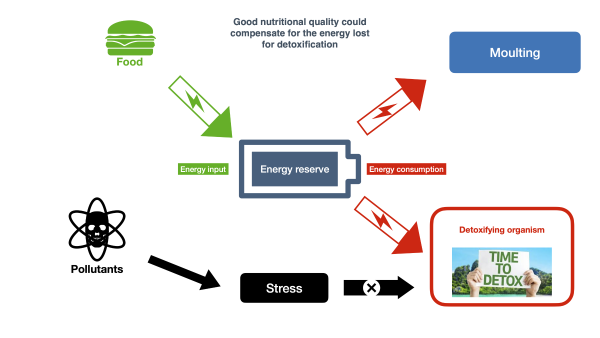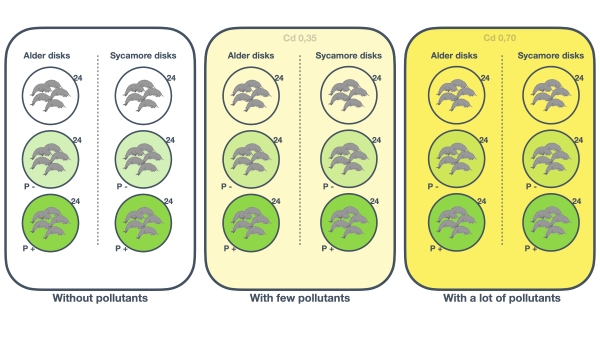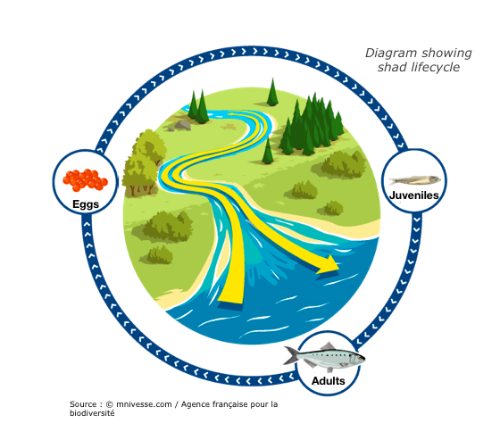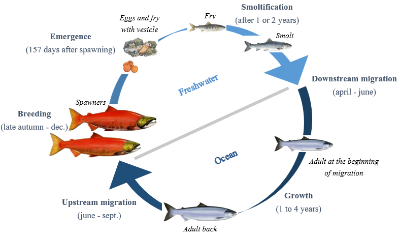How raising snails allows to better understand the dynamics of a parasite?by Thomas Boyer and Thibault Dindart
Published by the July 19, 2021 on 9:38 AM
The analysis of epidemiological dynamics depends on host and parasite interactions. But these interactions fluctuate because hosts and parasites are heterogeneous entities that exist in dynamic environments. Resource availability is a powerful environmental constraint of intra-host infection dynamics (temporal patterns of growth, reproduction, parasite production and survival).
In this study, researchers developed, parameterized and validated an explicit resource infection dynamics model by incorporating a parasitism module in the energy balance theory. The mechanisms explained are the multivariate dynamic responses of the human parasite Schistosoma mansoni and its intermediate host snail to resource variation and host density. This parasite is widespread in Africa and inter-tropical America. Worldwide, more than 200 million people are infected with it, 9 million suffering from its symptoms, which cause more than 200,000 deaths every year. It tends to have erratic localizations (liver, spleen) and the accumulation in these organs of lost eggs makes the severity of the infection.
The most common symptoms are diarrhea and even dysentery. Complications can appear such as rectal prolapse, fistulas, occlusion, appendicitis.
To do this, they have parameterized the model using an experiment that manipulates food resources and follows the growth, reproduction, parasite production and survival of snail hosts. The model is then validated by simulating the dynamics of infection for host individuals undergoing different levels of intraspecific competition and comparing these predictions with the results of another experiment that manipulated host and resource density, and hence the intensity of resource competitionThis bioenergy perspective suggests that variation in resource availability and competition could explain the infective dynamics of this parasite. To begin with, total cercaria production could be low when snail densities are low (because there are few infected snails) or when snail densities are high (if competition limits per capita parasite production). This potential relationship between snail density and the risk of human exposure could be the reason for the success or failure of current and proposed methods of schistosome control, which depend on reducing the density of snail vectors by molluscicides or predators. If resource competition in natural snail populations is strong enough, then snail reduction programmes could backfire, as reducing intermediate host densities could free the remaining hosts from resource competition, thereby increasing parasite production rates per host.
To conclude this bio-energetic model seems to indicate that the fight against the parasite Schistosoma mansoni begins with the regulation of snail populations (first host of the cycle). In order to better regulate this infectious dynamics, measures must be taken collectively between the countries concerned and must be directed towards a total reduction of snails or a limitation by intra-species competition. This model would establish priority levels of parasite infection for certain areas and would be followed by measures to control the parasite. A first measure would be the installation of pipelines to prevent the release of infected faeces into watercourses.
This post is licensed under a Creative Commons Attribution-ShareAlike 4.0 International License.Does food quality increases moult organism vulnerability to pollutant impacts? by Charlotte Couedel, Axel Rochaud and Stellia Sebihi
Published by the April 27, 2021 on 9:06 AM
Today's ecotoxicology
For a long time, ecotoxicology focused on the lethal effects of pollutants, with increased individual mortality translating into smaller population size or population extinction. There has been a shift from the study of lethal doses to the impact of smaller doses on more specific processes such as physiology and behaviour (Rand and Petrocelli, 1985; Døving, 1991). The article deals with the effect of pollutants on moulting.
Possible use of ecotoxicology (the case of the article)
Pollutants are an environmental factor causing stress in individuals. Lack of resources is another factor. For this reason, the study attempts to demonstrate and quantify the impact of food quality on the resistance to pollutants of moulting organisms.
Hypotheses of the effect of the diet on the assimilation and detoxification of pollutants
When a pollutant is assimilated by an organism, the body sets up the detoxification system, but it requires energy. Food allows the assimilation of energy by organisms. Good quality of food makes an individual capable of accumulating the energy necessary to ensure vital functions. An organism with energy from good quality food, should be able to activate an effective detoxification. Thanks to this detoxification, the body should be less impacted by pollutants. The study seeks to demonstrate whether this is true.
The interest of the biological model
Gammaridae are macro-invertebrates that are mainly detritus feeders. They feed on detritus, corpses, living or decaying plants. Moreover, they are at the base of the human food chain as they are often industrially bred as fish food. Gammaridae are used to determine the biological quality of watercourses. They are rather pollution tolerant organisms but are nevertheless affected by pollution. Could the physiological changes noticed in Gammaridae be noticed in humans?

A picture of two GammaridaeWay to understand the effects
The experiment is designed to evaluate single and combined effects of leaf litter stoichiometric quality and Cd exposure on G. fossarum survival and growth. Phosphorus (P) is used as the nutrient in leaf litter. Cadmium (Cd) is used as the pollutant. Phosphorus (P) is a nutrient naturally present in the Gammaridae's food, in this case, leaf litter. Also, industrial activities are often sources of cadmium released into aquatic environments. The main route of exposure to cadmium (Cd) is through the ingestion of contaminated water and food, so Gammaridae is particularly exposed to this type of pollutant.
144 microcosms were performed for each of the 3 levels of Cd concentrations (0 ; 0.35 ; 0.7). For each group, 72 microcosms were realised with Sycamore discs and 72 with Alder discs. It allows to observe the effect in different conditions. Then, among these 72 microcosms, three batches of 24 have been realized. The first batch is a control batch where the composition of the litter was not modified. The second batch was a P- batch, where the litter was deficient in phosphorus and therefore in nutritional value (and which does not allow individuals to extract a lot of energy). Finally, the third lot was P+, it was enriched in phosphorus, the nutritional value is very good.
Several metrics were measured to validate the initial hypotheses. The metrics were chosen for their relevance to evaluate organisms sensitivity to resources quality (leaf species and P content) and pollutant (Cd concentration in water): Cd bioaccumulation and survival rate. But also for their ecological importance: time-to-death, mass growth, time to moult and feeding rate.
Results to remember
- The Gammaridae's moult frequency and growth is amplified by a nutrient-rich diet (P+).
- A presence of pollutants (cadmium) in the Gammaridae’s life site reduces their growth and raise their probability of death.
- A nutrient-rich diet amplified effects of cadmium.
- If we make the connection: The higher quality of food ressources, the more moulting there is and the greater the effect of cadmium. So moulting makes Gammaridae vulnerable to pollutants.
- Species sensitivity to pollutants might be underestimated in ecosystems facing both nutrient constraint and pollutant.
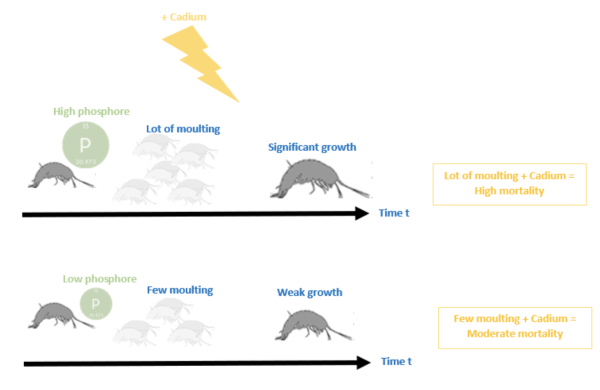
Schematization of the main resultsWhat to infer from this experiment.
The presence of pollutants in the water causes problems in the survival of Gammaridae. Ecotoxicologists are well aware of the bioaccumulation of pollutants in the food chain. As a result, a predator will be more contaminated by the pollutants than is prey. Indeed, predators will keep in them the majority of the pollutants present in their prey. Thus, humans present in the upper part of the trophic chain will be much more contaminated than the Gammare.
So why discharge pollutants into the water? Let's drink it directly!

This post is licensed under a Creative Commons Attribution-ShareAlike 4.0 International License.A new way to understand the effects of toxic compoundsby Flore Emonnot and Anne Michaud
Published by the September 7, 2020 on 8:07 AM
Water pollution is a major concern. It can be induced by many elements. For example, Cadmium (Cd) which belongs to the heavy metals family can be source of pollution in certain concentrations. This element is naturally present in the environment, but the use of agricultural chemicals has been indicated as the main anthropogenic source of Cd pollution in aquatic environments. The organisms living in these aquatic ecosystems are exposed to this pollution. Moreover, this compound is bioaccumulated in organs and tissues, so it can induce damages.
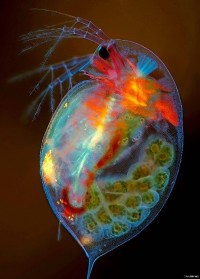
Daphnia magnaThat is why it is important to evaluate the effects of this pollutant on organisms. Daphnia magna (a cladoceran crustacean) is one of the most widely used animals in aquatic toxicology. In terms of sensitivity to toxic substances, it is generally thought to be representative of other zooplankters (Anderson, 1944). It plays an important role in the balance of an ecosystem, because of its position on the first levels of the food chain. Also, D. magna enhances water purification by filtering water and retaining food particles, it is its way to eat. This animal spends its whole life in a variety of freshwater environments. As long as the conditions remain favourable, it reproduces predominantly by parthenogenesis.
Bioassays are used in aquatic toxicology to provide individual-level information, while ecotoxicology is assessing the impact of pollution on populations. The DEB theory (Dynamic Energy Budget) is a theory that describes the aspects of metabolism (energy and mass budgets) at the individual level. Food assimilation results in energy, which can then be used for reproduction, growth or maintenance (life-history traits). The DEBtox is a toxicological application of the DEB theory which attempts to assess the effects of pollutants on life-history traits over time.
The key challenge is how to infer the impact of toxic effects observed in individuals and apply it to an entire population. Elise Billoir and her team combined the following tools to extrapolate the individual effects to the entire population:
The DEBtox is a good way of modeling survival, reproduction and growth continuously as a function of time and exposure concentration and at the individual level.
The population growth rate (which incorporates lethal and sublethal effects), is the best parameter to evaluate the risk of a pollutant on a population, hence matrix population models are a useful tool. Billoir explains that in population matrix, population is divided into classes based on development stage, and individuals transfer from a class to the next one depending on their survival and their fecundity.
By combining DEBtox theory and matrix population models, it is possible to extrapolate every effect of the toxic compound on the individual to the population level (as explained in the synthetic diagram below).
This technique used by Billoir, has not yet been used in an ecotoxicological context. It consists of reorganizing all the age-specific information in a stage-specific way. This way it makes possible to compare the sensitivity in the face of cadmium and in relation to the age of the individual.
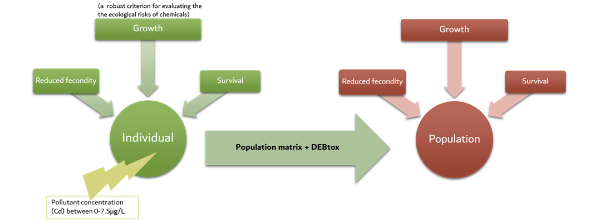
Diagram of the method developed in the study of Billoir et al.In this case, the sensitivity analyses showed that the effects of cadmium at the individual level were not significant but the application of the model proved that the population growth rate is highly affected through the cadmium contamination. Moreover, we think that this model could be applied to similar aquatic organisms and other pollutants such as heavy metals and could be useful to enhance existing bio-indicators of water quality.

This post is licensed under a Creative Commons Attribution-ShareAlike 4.0 International License.How to adapt your birdly behavior to the river flow?by Mireia Kohler Pacino and Oihana Olhasque
Published by the May 4, 2020 on 2:05 PM
The natural flow regime paradigm and the aim of study
In 1997, the natural flow regime paradigm has been established. This paradigm has become a real basement of management and basic biological study of running water ecosystems (Poff et al., 1997). This one establishes that the temporal variation in river flows requires the adaptation of structure and function of the aquatic ecosystems. To better understand this adaptation, many animals have been studied. In our case, the Cinclus Cinclus is chosen because of his large distribution in the world. We want to figure out if his behavior and energy use strategies are dictated by the natural river flow. We’ll use time-activity and time–energy budgets. In fact, it has proved to be a convenient approach to assess a bird's use of time and energy expenditure.
Using time-activity budget
Different behaviors of dippersTo answer to this question, the time-activity budget of the White-throated Dipper (Cinclus cinclus) was studied within a water basin in the Pyrenees, where natural flow regime is highly seasonal. To study the time activity budget, bird activities were categorized under four main headings: resting, foraging, diving and flying. In the study, between October 1998 and August 2001, birds activities were monitored each month using a portable tape recorder in combination with a telescope at a distance of 30–100 m. Overall, the analysis was made on 130 recordings: 62 males, 52 females, and 16 birds of unknown sex. As strategies could depend on external and river conditions, air temperature, water temperature and water column depth were measured on the behavioral surveys.
Parameters used in the study
Authors assumed that the Daily Energy Expenditure is calculated from an equation that includes time-energy budgets (obtained by incorporating time activity data), basal rate of metabolism, thermoregulation, locomotion, foraging, digestion, growth, reproduction, as well as all energy expenditures that eventually end up as heat production. The required foraging rate and the observed rate of energy gain were also calculated by dividing Daily Energy Expenditure with, respectively, the active day length for birds and the total time spent feeding by birds. Consequently, the ratio “Observed rate of energy gain” / “Required foraging rate” indicates how much faster observed feeding rates are in relation to minimum required feeding rates. For example, if birds gather food at a rate just enough to balance their energy budget then this ratio is equal to 1.
Parameters used in the DEE equationResults synthesis
The natural river flow is high during snowmelt (between April and June) and very low in summer. The behaviors are also chasing due to season: In winter our birds spend more time in foraging where food is rarely found and the water flow didn’t increase. In May, went the river flow increase, they have a rest for 70% of the day. Diving, flying and other activities showed no peculiar pattern, but there’s a relationship between water stage and time spent diving. Moreover, the ratios, observed rate of energy gain / required foraging rate indicated our birds could face high energy stress during winter but paradoxically none during high snowmelt spates when food is expected to be difficult to obtain. Unfortunately, the daily energy expenditure doesn’t seem to show any annual pattern. At this step of the study, they couldn’t find out whether Dippers use an energy strategy.
To go further....
With the actuals methods like calorimetry will be a complement to this study. To figure out, more information about dippers cycle life and potentials energy strategies. More generally, this study will serve the overwhelming challenge of maintaining native birds (especially those at risk) and more generally speaking biodiversity in human-altered rivers and streams.

This post is licensed under a Creative Commons Attribution-ShareAlike 4.0 International License.Shad, those endangered travelersby Alicia Dragotta and Claire Valleteau
Published by the April 6, 2020 on 1:52 PM
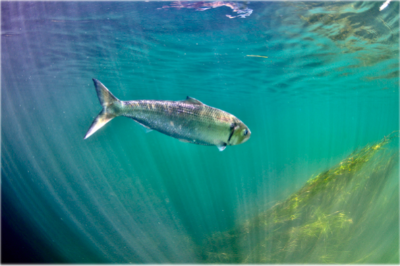
Photograph by MRM associationShad are migratory fish that travel great distances between sea and river in order to reproduce. These long journeys are the source of great energy expenditure, particularly to find the most favourable spawn environment. These species are considered bio-indicators of our waterways. Their presence or absence indicates the ecological state of the water. Migratory distance was governed by energetics, behaviors, maturation, and upstream delays at dams. Individual adult migrant American shad (Alosa sapidissima) ascend the Connecticut River and spawn, and survivors return to the marine environment. Theodore Castro-Santos and Benjamin H. Letcher presented a simulation model of these behaviors.
The purpose of this model is to evaluate the effects of biological and physical variables on adult spawning success and survival. Only energy devoted to migration has been taken into account in the model. Physiology and energetics strongly affected distribution of spawning efforts and survival into the marine environment. Delays to both upstream and downstream movements had dramatic effects on spawning success. Other factors influencing migratory distance included entry date, body length, and initial energy content. Furthermore, dams alter reproductive success and have an impact on migration (delay).
This model suggests shad that spend more time in the river have greater spawning success but are more likely to die of energy depletion. Many important factors in the models presented here remain enigmatic. Perhaps the most important question is what causes shad to reverse direction and migrate downstream. Do both energetics and maturation play a role ?
Answering this question could be difficult but may be possible using, say, a combination of physiological telemetry (e.g., Hinch et al. 1996) and data on reproductive status, especially of downstream migrants. The purpose of this paper was to develop a management tool to evaluate the relative importance of biological and physical factors on shad reproduction and survival. Restoring access to spawning habitat by providing fish passage has been a central management strategy. Ecological continuum is very important to preserve species, including these migratory fish. Dams for example, were built for many reasons, at the origins in order to mill operations, and today for hydraulic energy exploitation. We have to reconsider the interest of these dams, remove those which are useless and adapt the others. This process has been under way for several years, opening the door to restoring access to the rivers.
Read the full study: Castro-Santos, T. and Letcher, B.H. (2010) Modeling migratory energetics of Connecticut River American shad (Alosa sapidissima): implications for the conservation of an iteroparous anadromous fish. Canadian Journal of Fisheries and Aquatic Sciences. 67(5): 806-830. https://doi.org/10.1139/F10-026

This post is licensed under a Creative Commons Attribution-ShareAlike 4.0 International License.
Are pesticides more dangerous when you are hungry?by Angèle Lorient
Published by the January 6, 2020 on 1:52 PM
Today, the impact of pesticides on our environment is a central issue in many publications and a major concern for all citizens. Between 2014 and 2016 the use of pesticides increased by 12%. Indeed, intensive farming currently used implies that we find in our food, in the air but also in water, traces of pesticides. A 2013 Inserm report highlights a link between exposure to pesticides and the appearance of cancer or pathology such as Parkinson's disease but also developmental problems on children. Therefore, they harm the health of humans but also the entire terrestrial and aquatic ecosystems.

Water Flea Daphnia Magna. www.aquaportail.comIn addition to using a large amount of chemicals, modern farming methods make soils less permeable. As a result, precipitation runoff is a major contributor to pesticide pollution from our streams. In order to study the toxicity of pesticides in the aquatic environment, the majority of laboratories use Daphnia as an indicator of water quality, and in particular the species Daphnia magna for their sensitivity to toxins.
Daphnies are small crustaceans measuring about 1 to 4 millimeters. They live mainly in fresh water (river, pond, lakes). They are filter feeders that help maintain the clarity of the water thanks to their ability to eat green algae. During a day they move between the bottom and the surface of the water depending on the light (photoperiod).
In 2006 a study was conducted by 4 scientists (2) to study the physiological responses (sensitivity, growth, reproduction) of daphnies to different dietary concentrations of the same pesticide to which they and their mothers were subjected. (high food or low food).
The study shows that lack of food does not play a direct role in the sensitivity of daphnies to the pesticide in question. However, it is one of the factors determining the level of absorption and elimination of this toxic substance by the body. In addition, the energy used to fight this toxin has a negative effect on the maintenance of vital functions.
In a period of low availability of food resources, invertebrates will have a more limited growth and a lower reproductive rate in proportion to the level of pesticide present in their environment. While the impact is less when they are subject to sufficient food resources (Fig 1).
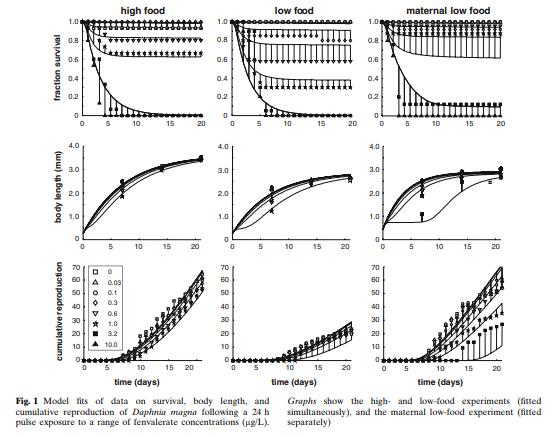
For the different types of food resource, the effect of the pesticide concentration is proportional to the survival rate. On the other hand, we can notice that there is a threshold effect concerning growth and reproduction.
However, they also highlighted that these individuals, when no longer subject to the pesticide, found a normal activity (resilience).
This study makes it possible to highlight the potential impacts on the results of the experiments if certain non-standardized conditions vary between laboratories (concentration of food, respect of the photoperiod). As well as the differences in test organism responses between conventional environmental conditions (controlled artificial environment) and the natural environment (subject to variations).
The analysis of the results of this study raises the following questions:
- What is happening in the longer term?
- Does the repeated presence of pesticide pulses have the same physiological effects on an individual throughout his life?
- Is the speed of resilience due to the species or can it vary individually?
- Is there resiliency of newborns from underfed mothers?
It also shows the urgency of taking into account the impacts of pesticides, both on our current health, on the heritage that we will transmit, but also on our ability to reproduce. Despite the mobilization of the Ministry of Agriculture including the program "Ambition bio 2017" there is urgency. Pesticides are one of the main causes of pollution in our waterways. This pollution endangers aquatic life, as has been demonstrated, but also the drinking water resource. Should not our entire consumption system be called into question in order to be able to realistically implement the planned management plans?

This post is licensed under a Creative Commons Attribution-ShareAlike 4.0 International License.What does the future has in store for red salmon in a context of global climate change?by Camille Sestac and Amandine Tauzin
Published by the November 1, 2019 on 1:18 PM
Pacific salmon have extremely complex life histories and may be threatened by global climate change, as Peter S. Rand and colleagues investigate in their recent study.
Among all species, fishes must adapt to face disruptions caused by global climate change. Sockeye salmon (Oncorhyncus nerka), an anadromous species of salmon found in the Northern Pacific Ocean and rivers discharging into it, has a complex life cycle. As a migratory species, their energetic demands are high during spawning migration. Climate change might have important impacts on populations and their migration via variation of river discharge, increase of water temperature and decline of growth conditions. Aiming to better understand the impacts of these disruptions on the migratory performance of this species of salmon, Peter S. Rand from Wild Salmon Center teamed up with researchers from British Columbia. Their goal is to evaluate the effects of past and future trends in river discharge and temperature on the migratory performance of Sockeye Salmon in the Fraser River.
In a context of global climate change, it is crucial to understand the effects of disruptions on ecosystems and the populations living in them. Indeed, it is important to know the impacts of these disruptions on every stage of their life cycle (the juvenile freshwater period, the estuarine period, and the subadult marine period) so that we can maintain the populations stock. It’s especially important for fishery management because the fishing quota has greatly increased over the last decades and has threatened populations of Pacific salmon, particularly during their spawning migration. That’s why with three main objectives, these scientists used analysis to improve the understanding of how changes in river conditions can affect the energy use and the mortality rate in Sockeye salmon population. To do so, they used several models: one to search a link between energetic conditions of individuals and en route mortality, one to simulate the energy use during spawning migration and one to hindcast and forecast energy use by simulating fish’s behaviour and migration conditions (for more information, a tip, read the article!).
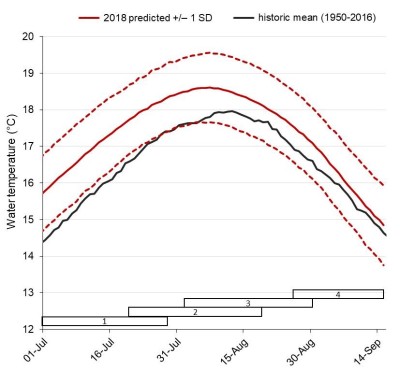
Long-range forecasts of lower Fraser river temperature during the summer of 2018Using these friendly models, Rand and his colleagues proved that energy reserves and energy depletion of early Stuart Sockeye salmon are major factors that can affect their ability to reach their spawning grounds. They also stated that energy depletion is a function of both river temperature and discharge. Therefore, this population is structured by condition-dependant mortality. Nevertheless, this group of researchers brought to light a mechanism that allows fishes to cope with some environmental variability, providing a certain degree of resilience over time. Therefore, even if energetic demands and migration mortality increase as a result of exposure to warmer temperatures, it will be compensated by reduced time travel to the spawning ground as the river flow will be lower.
However, increase of temperature means increase of diseases appearing and developing and that stress added may be a direct cause of increased mortality during migration. Finally, as if it wasn’t already bad enough for our salmons, ocean productivity can be affected by climate change and thus affect their river migration success. In fact, this can lead to a decrease of body size and body energy content. It implies that individuals will start their migration with lower energy densities and will be more likely to exhaust their energy stock before even reaching the spawning grounds.
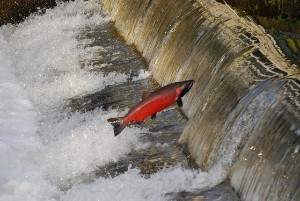
Salmon jumping over a weirAccording to the US-Canada Commission, a 21° C temperature spike was measured on the Fraser River in 2009. However, sockeye salmon show signs of physiological stress and migratory difficulties above 19°C and from 20°C, the first signs of illness and death appear. But migration of Sockeye salmon is not only threatened by climate change. In fact, migration of salmon specially is impacted by humans or natural obstacles. Dams and weirs form large obstacles for this migratory species and can be very difficult to cross. Many studies have already proved that this kind of obstacles, even when equipped with crossing devices, delay their migration and thus jeopardize their reproduction. This can lead to a decline of the population and in some cases to its extinction, as it happened in Belgium.So, whilst some questions have been answered, it seems that more studies need to be carried out to improve our knowledge about the impact of global change which seems to be another sword of Damocles hanging over the head of Sockeye salmon.
Cited paper: Rand, P.S. et al. (2011) Effects of River Discharge, Temperature, and Future Climates on Energetics and Mortality of Adult Migrating Fraser River Sockeye Salmon. Trans. Am. Fish. Soc. 135(3), 655-667. https://doi.org/10.1577/T05-023.1
Featured images: Life cycle of Sockeye salmon by Camille Sestac, graph from https://www.pac.dfo-mpo.gc.ca/science/habitat/frw-rfo/index-eng.html , Sockeye Salmon from www.ryanvolberg.com

This post is licensed under a Creative Commons Attribution-ShareAlike 4.0 International License.Organisms and their environment: Dangerous liaisonsby Marius Dhamelincourt and Charlie Sarran
Published by the October 14, 2019 on 9:15 AM
Preface
Whatever the incredulous think, organisms are necessarily linked to their environment to survive, science says. However, this relation, unstable, can be problematic for those concerned when variations overtake their acceptable thresholds. Although often natural, these variations can be exacerbated by anthropogenic actions, like putting fish on a grill.
Global changes are often reduced to temperature increases, illustrated in the media with alarming news about ice melting and forest fires. While many people thus omit the complex mechanisms behind this black box, the necessity of a more “polar bear’s” respectful way of life is commonly accepted. In order to better understand how to respect such adorable creatures, scientists need to investigate their relationships with the environment.
Chapter 1: Shells under investigation
In order to scrutinize these relationships, selected species must be accessible, easy to catch/manipulate and in sufficient number. For instance, the study of the great white shark aggressivity over humans would require too many intern’s sacrifices. In response to this challenge, a valiant research team from Germany looked for the importance of these relations by studying in the Rhine a remarkable (body and soul), accessible, cheap and lovely species: Corbicula fluminea, a shell. This study is related to the mass mortalities events of this species, which occurred in the summer, especially in that of 2003. Their investigations aim to understand how these organisms are linked with their environment, and their reactions to changes.
Chapter 2: Shells cooking in science
Corbicula fluminea shellsMany tools exist to perform this type of search. Field searches can involve the scientist’s life (be bitten by a pigeon is a terrible experience…) and obstruct a long-term individual experiment. Now that researchers have selected the perfect organism, they must choose an appropriate way to analyse their problem. For this shell, scientists chose to use a modelling approach, a method dark and full of terrors. More precisely, they modelled several aspects of the metabolism of this organism at different scales: individual and population levels, using respectively DEBM (Dynamic Energy Budget Model) and PSPM (Physiologically Structured Population Model). This method, widespread in ecology, consists to “simulate the annual growth in length and mass and the reproductive success under different environmental scenarios”. This approach is suitable because an organism can respond differently relatively to their peers. Such fact can be proved by looking at many places and species, humans included… Ultimately, scientists aim to better understand the complex relation between the energy available in the environment and its utilization by shells.
Chapter 3: Corbicula’s deadly summers

Heat waves are often responsible for changes that every scientist can observe on living organisms. For instance, it is known that coral reefs are affected by increased temperatures, as shown in an article published in “Free Radical Biology and Medicine”. Many other examples such as lobster’s behavioural response to boiling water could be developed. Regarding our shellfish, scientists found an interesting pattern comforting our previous remark: temperature causes shell’s mortalities… Oh wait, no, it’s more complicated.
In fact, mass mortalities events were probably related to a melting pot of many events like temperature increases and/or starvation. Moreover, these situations are also in relation with individual conditions. Indeed, researchers hypothesized that a combination of factors (biotic and/or abiotic), usually non-lethal under regular summers, can be problematic at high temperatures. Unfortunately, models developed were not able to explain completely the observed mass lethal events.
Chapter 4: Life is not so simple
Researchers finally enhance the comprehension of population dynamics, enlightening its complex mechanisms. However, in such cases, wishing to be exhaustive is useless and unproductive, like politics. That is why scientists look for compromise between easy-to-use and complicated (highly realistic) tools. For example, the authors of the Corbicula’s study proposed that it could be interesting to test other parameters, such as parasitism.
To put it in a nutshell (you got it, right?), things are not always what they seem to be, even in environmental studies. Main hypotheses are not always validated, and measures considered can be only a part of a more complex system, or sometimes even unappropriated. On the flip side, model’s development can help to understand the life cycle of organisms like Corbicula, thus helping to manage populations concerned.

This post is licensed under a Creative Commons Attribution-ShareAlike 4.0 International License.Avoid predation or starvation: which strategy maximize rainbow trout juvenile survival?by Léa Bulon and Mylène Jury
Published by the September 9, 2019 on 7:12 AM
Natural populations are increasingly exposed to a range of biotic stressors, such as predators, and abiotic environmental stressors such as environmental variations (seasonality - Wingfield, 2013) or chemical pollution (Fisher et al., 2013). (We could think to grandma Margaret who throws away her bleach bucket directly into the river or grandpa George who loses all his plastic lures into the lack). The first year of life is complicated for all organisms because they are more sensitive to those kinds of stressors and their survival is highly impacted.
In temperate zones, fry are subjected to high predation during the growing season and a nutritive resource deficit during winter. This is why juveniles need to find the best way to maximize their survival and make population viability durable through the time. Predators prefers a fry-up of little fish, it is why predation mortality is higher in small fish than large (Parkinson et al., 2004). However, growth itself may impose a significant energy mobilization which can drive trade-offs between growth and other metabolic processes. If you are really interested by the topic but not by fish, we recommend you to look at the article written by Mcleod et al., 2008, about birds.
During winter, the metabolism needs some fuels like lipids and proteins to work because resources are often limited. Production of energy storage is energetically expensive, and energy contributes less to increasing their body-size.
Is it better to allocate their energy into the growing season to avoid predators or into the lipid storage to survive during winter?
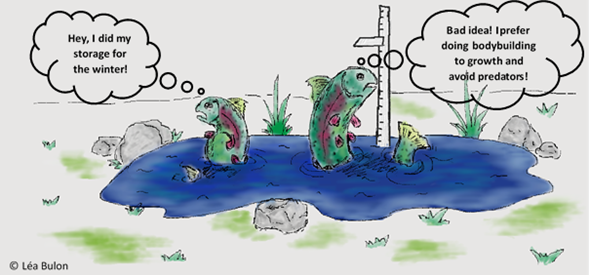
To store or to grow? That is the questionStephanie Morgensen and John R. Post, scientists from Canada, are been interested in this process. They led an experiment with juvenile rainbow trout (Oncorhynchus mykiss). They developed a mathematical model to determine the energy allocation strategy maximizing the first-year survival of rainbow trout.
Rainbow trout juveniles are sampled from two sets of lakes in British Columbia in Canada. The first site is located on the Bonaparte Plateau and it corresponds to highly and cold lakes. The second site is located near the town of Merritt and it corresponds to low altitude and warm lakes. In warm lakes, the winter season is shorter than in cold lakes and there are more resources for juveniles.


Canada: birthplace of the rainbow troutThey found that juvenile growth is different between the two kinds of lakes: fish from the cold lakes growth more than fish from warm lakes. As we said before, production of lipid storage consumes more energy than growth and resources are more abundant in warm lakes. It is why, fish from warm lakes are more able to stock and fish from cold lakes, to growth. However, fish do not follow only one strategy. Indeed, they grow during the first part of the non-winter season and then they put their energy into the lipid storage to survive during winter. This switch between the strategies is controlled by environmental conditions and determined trout survival during winter.

How many fish survive during winter?The juvenile survival trade-off influencing by environmental conditions such as temperature and resource availability would be important to understand population viability with the evolution of environmental conditions. Rainbow trout has been introduced into many streams and water bodies for recreational fishing because they are easy to catch and quite combative (fishing federation). They constitute an important economic interest it is why, it is one of the most studied species by biologists (INRA). This may lead to management measures to improve pisciculture conditions or to instore fishing quotas and a minimum size of capture. It could be also interesting to know if energy allocation strategies affect physiological processes like growth or reproduction.
And you what would you choose to survive during winter?

This post is licensed under a Creative Commons Attribution-ShareAlike 4.0 International License.Zinc pollution of our rivers: shrimp on alertby Lucille Baron and Macha Joanin
Published by the August 12, 2019 on 10:03 AM

An individual of Gammarus pulexNo, we will not make an exhaustive catalog of the pollutants that affect our streams and boredom will not settle in your heads by reading us. Instead, we have chosen to discuss the effect of one of the very present emerging pollutants zinc on Gammarus pulex, through the study of Maltby and Naylor (1990).At present, world zinc production is over 13,000 kilotons (2018). Zinc is commonly used in metal corrosion coatings and for the manufacture of fertilizers and pesticides (European Commission, 2008b). Thanks to its physico-chemical properties, zinc melts particularly in fresh water, and it is absorbed on suspended solids and sediments (INERIS, 2014). All organisms living in these ecosystems are therefore exposed to this pollution and therefore, indirectly, we too, human.
Thus, it is important to measure the risks of this exposure on organisms and especially to know the effects of zinc on populations in the long term. For this, researchers have studied, experimentally, the energy deployed in the reproductive mechanisms by aquatic organisms exposed to zinc at different concentrations. In additions, they sought to know if exposing females during a first brood (called current) could have an effect on their second brood unexposed (called subsequent).
Gammarus pulex is a sentinel species, not only because this shrimp is abundant in fresh waters of England, but in addition it is fed with particulate matter which constitutes, in the natural environment, a large zinc stock. To measure the risks of maintaining the species and the genetic heritage of each individual under the effect of zinc, it is sufficient to study the offspring of females exposed to this compound at different concentrations. The number of individuals which hatched, and the size of each one give some indication of the energy allocated to reproduction. That's what researchers at the British Ecological Society did. If you haven’t understood anything about our attempt to explain the methods used to carry out the study experience, here is a summary diagram that you may be clearer!
Diagram of the methods used for the experimentThe results they obtained are surprising and show that exposure to zinc (even at low concentrations) significantly increases the number of broods aborted. This result is related to the decline of foods assimilated by females when they are exposed to zinc. The total energy drawn from food is no longer sufficient to sustain metabolic needs while maintaining the mechanisms of maturation and reproduction. Nevertheless, when exposed females carry her brood to term, the number of offspring of each does not seem to vary, despite of the difference in duration of exposure. So, a small criticism of the Figure which represent the percentage of broods aborted in function of the concentration of zinc (Figure 3) can be realize : we found in the control situation (not exposed to zinc), a great variability between the two categories tested. So, in science when the" control "already has significant variability, the results should be interpreted with caution thus it is difficult to conclude to a difference between the current and the subsequent.
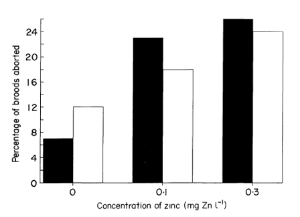
Effect of zinc on the percentage of broods aborted. Solid columns (black) represent “current” broods and open columns “subsequent” broodsThe results concerning the size variation of the descendants, bring a complementarity to this analysis because the researchers observe a reduction of the size in the generations following the exposure. It is the reduction of the available energy (females stopping feedings) which as a consequence the reduction of the size of the individuals of the next brood. Also, on this point, it is unfortunate that the study does not take into account the size of the female that could have an impact on the size of the offspring (Taïr-Abbaci K., 2016).
The increase of the number of broods aborted and the decrease of the size can have a negative impact on the fitness of populations as exposure to zinc increases abortion. Also, the smallest offspring will take longer time to mature and under stress conditions, this phenomenon may be aggravated over generations and the snowball effect may strongly decreased fitness of individuals. Ultimately, these effects can have a profound impact on the entire population.
The study seems relatively far from reality since it remains experimental, in the laboratory, and is not carried out in a natural environment and therefore with real conditions of experimentation and exposure to zinc. Thus, the adaptations set up or not by the organisms and the cocktail effects (potential combined effect of different compounds) are not taken into account.
Nevertheless, the study above begins to be old, the latter dating back to 1990.Today, techniques allow to observe the embryonic development precisely and it turns out that during the different embryonic stages aberrations can appear (Bach et al., 2010). Then, it is difficult to think that abortion is the only response implemented by females when exposed to these chemical compounds.
In addition, reproductive success does not depend solely on embryonic development. It is important to consider the energy allocated to ovocyte development and the search for sexual partners to define the impact of zinc on the Gammarus pulex cohorts.
It’s possible to reduce the production of zinc with recycling it. However, the recycling of metals can sometimes be too expensive for small industries or privates companies. So, there are other ways than the installation of water decontamination mechanisms. Thus, bio-decontamination can be considered for these companies or industry but can also be useful to large industry in addition to their mechanisms for an exhaustive decontaminations and better water quality. Agriculture is also a source of metal pollution, so it is important to carry out hedgerows planting campaigns near fresh water since they have the function of absorbing a large part of the contaminants resulting from the leaching of flooded soils.

This post is licensed under a Creative Commons Attribution-ShareAlike 4.0 International License.
A damned energy loss for migratory fishes: dams!by Manon Salerno
Published by the June 10, 2019 on 9:42 AM
Many species of fish grow in the sea and breed in rivers. These migratory fish are called anadromous. When a migratory fish is ready to breed, it leaves the sea and up a river to lay watershed upstream. It will find the optimum conditions to reproduce and allow the development of its offspring. But to do so, they spend a lot of energy on the upstream and sometimes, obstacles like dams in their path does not make it easy for them. This is the case of American Shad in the Connecticut River in the United States. Since the 1970s, 4 hydroelectric dams have been built in the river. Even if they are equipped with fish ladders, these obstacles require the Shad more energy to cross them than if they were not present. We know energy availability can be a limiting factor in migration. Thus, in 1999, scientists wanted to understand energy management in these fish, especially when it is modified by the presence of such.
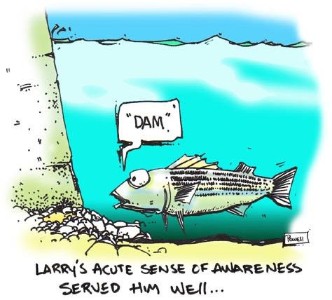
Any organism needs energy to perform the movements / migrations necessary for its life cycle. When they are heading into a period that will not allow them to feed (overwintering, migration), some species store energy, such as the bear before hibernating. For American Shad, this stock has to be created before migration because it will not feed during this move. First, scientists have found these are subcutaneous lipid reserves and skin constitute a special tissue for energy storage, which is rather unusual. Salmon, for example, usually mobilizes lipids from muscles and viscera. In contrast, for migration, somatic tissues (red and white muscles and skin) provide about 90% of the energy required in shad.
Although fish ladders are quite efficient at the upstream for the American Shad, it is sometimes not suitable for other species. In addition, the outmigration can also present risks of mortality (water retention, drop height etc ...). It is therefore essential to remove the dams for which their function is not provided anymore. But in the United States, the erasure of small dams often meets opposition from local communities. Even though many dams have been removed, they represent a strong historical or landscape value for the inhabitants, creating tensions between the supporters of the restoration and the local communities. This situation reminds the context existing in France, where the aesthetic and historical arguments are very powerful. Many dams are attached to mills and water plants of olden times are therefore seen as a "living historical landscape" very characteristic of their landscape. Because of the local character of each operation, an opposition not necessarily collective but influential and well directed, is enough to block some sites.

This post is licensed under a Creative Commons Attribution-ShareAlike 4.0 International License.Effects of an exotic prey species on a native specialist: Example of the snail kiteby Mathieu Finkler and Hyppolyte Terrones
Published by the September 11, 2018 on 12:34 PM
Exotic species have largely been studied over the years, their effects on native populations, their consequences... Most of the studies aim to see the competition between a native species and an exotic one. Here the study focus on the effect of an exotic species on a native predator.
Florida snail kite (Rostrhamus sociabilis plumbeus) are endangered, their populations are drastically declining in recent years. It is important to study them and to determine why their numbers are falling to implement an adapted conservation strategy.
The purpose of the study is to assess the effects of the recently introduced island apple snail (Pomacea insularum) on snail kite behavior and energetics comparing with the native prey (Pomacea paludosa).
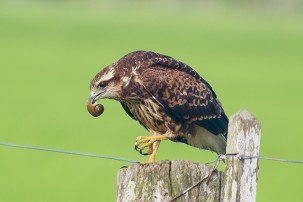
Juvenile snail kite - Cláudio Dias Timm - CC BY-NC-SA 2.0The authors determined different parameters such as the proportion of snail dropped, the searching and handling time, the consumption rate and proportion of time in flight. Caloric intake of both species has been determined by a model (Sykes 1987) and so is the daily energetic expenditure. Caloric balance seems to be perfectly suitable in this case because the difference in intake calories could affect all the life history traits and be the cause of the fast decline of the kites.
Foraging on exotic snails led to a greater proportion of snails dropped, a lower consumption rate, a longer handling time and a lower energy balance (figure below). These conclusions are particularly true and worrying for juveniles. This results indicates that feeding on exotic snails will decrease their energy and so less energy will be available for others activities (like reproduction, growth, defence against predators...). Finally, lakes where only exotic species are present (Tohopekaliga) could form an ecological trap.
From Cattau et al. 2010Even after this study, it will be hard to conclude on an optimal foraging theory because both snail species were never found together in a lake. Therefore it could be interesting to make the same study in a lake were both species are present. Furthermore, this study has been conducted during the breeding period. During breeding period, species will need more energy to feed their offspring, to protect them, potentially leading to a greater difference in energetic balance.
Further studies may focus on the fact that kites feed on larger exotic preys (compared to native preys). Are the smallest individuals not available for kites or do kites choose to feed on larger exotic preys to compensate for their lower energetic content ?
This method could be used in others studies of trophic relationships and not only on native-exotic conflict. For example if human overfish a species, the predator of this species will have to change preys. So it will be important to calculate the energetic balance with the new prey.

This post is licensed under a Creative Commons Attribution-ShareAlike 4.0 International License.Temperature-dependent body size effects determine population responses to climate warmingby Alison Arraud and Laura Duran
Published by the July 5, 2018 on 1:55 PM
Up to now, neither the size nor the stage of the individual were considered to studying the population responses to climate warming. On 2014, a scientific group proposed another way to understand the temperature effects on fish populations. They improved the interaction effects of temperature-dependence with the size and the stage of fish on their energetic thresholds responses. Energetic thresholds themselves act on the dynamic of stade-structured population (e.g. parr, smolt, adult).

Flathead mullet (Mugil cephalus) - Roberto Pillon - CC BY 3.0 UnportedFinally, this study found that increasing temperature could redistribute biomass across life stages and modify the regulation of the population by reworking the intra-specific competition. Other studies have shown that high temperature during ontogenesis can accelerate the development and growth of individuals or, give individuals of smaller sizes early maturation.
This study points out the importance of taking into account the interactions between temperature and size-specific (maturing, reproduction, etc.) that will lead to a set of behavioral responses that have consequences on the structuring of a population. This is all the more important in the context of global warming.

This post is licensed under a Creative Commons Attribution-ShareAlike 4.0 International License.Can bioenergetic models help the re-introduction of the native Rio Grande cutthroat trout in a Southwestern headwater stream?by Emmanuel Bourgoin and Aurélien Callens.
Published by the May 16, 2018 on 1:47 PM
Re-introduction of native species is far from being simple: many parameters must be accounted for! To illustrate that, we are going to take a closer look at a study made by Kalb and Huntsman (2017) on a stream in southcentral New Mexico which was deemed suitable for re-introduction of the native Rio Grande cutthroat trout (Oncorhynchus clarkii virginalis). Before re-introducing this species, researchers wanted to know if the habitat was able to sustain it. Thus, they evaluated habitat using resource selection functions with a mechanistic drift-foraging model to explain rainbow trout distributions. They studied rainbow trouts because they are present on the stream and are close relative to the Rio grande cutthroat trout, consequently all the results of this study can be extended to this native species.
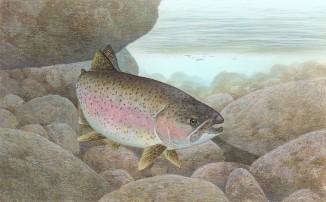
Rainbow trout - Timothy Knepp/U.S. Fish and Wildlife Service - Public domainEach month, the available habitat and foraging locations were evaluated along the stream. Foraging locations were defined as the location where they could observe a foraging fish. For each foraging site, the length of the fish was estimated and physical characteristics such as discharge, focal velocity (current velocity at the head of the fish), depth, cover distance and temperature were measured on the exact fish location. These parameters were also measured on the available sites. Macroinvertebrate drift was estimated on all the locations (available and foraging). All these parameters were used in bioenergetic models which allow the researchers to estimate all the intakes of the fish (net energy intake, energy assimilated…) and all the costs associated with foraging (capturing a prey, swimming…).
First, they observed that macroinvertebrate drift was strongly season- and temperature-dependant with high values in summer and fall and low values in winter and spring. Moreover, as we must expect it, water temperature, depth and discharge were found to be seasonal parameters too. Secondly, models identified the depth as the most limiting factor for habitat selection: trout of all ages preferred habitat location with a greater depth. The most interesting thing about the models is that they can show the characteristics of the chosen habitat according to the age of the trout and the season. In fact, they showed that during the winter the smaller size-classes were more likely to choose a position closer to cover. Additionally, they highlighted that spring was the season with the greater energy intake for all the size-classes expect the 4+. Finally, drift-foraging models identified that 81% of observed trout selected positions could meet maintenance levels throughout the year and 40% of selected habitats could sustain maximum growth. Despite these last observations, the larger size-classes were energetically more limited throughout the year.
This study showed that trout population prefers deep pool habitats with slow moving water and that this stream was able to sustain a great population of rainbow trout and could consequently sustain a great native population of Rio grande cutthroat trout. However, authors warn us about the risk of hybridization and interspecific competition and suggest removing the non-native fishes first.
To answer the question in the title: yes, bioenergetic models can help to re-introduce a native species in a given environment. Nonetheless, this example is really specific: author had the chance to find and study a close relative to the native trout in the stream! The main thing to remember is that bioenergetic models give a lot of useful information on how a species uses an habitat and must be taken into account (if applicable) in the management of species.

This post is licensed under a Creative Commons Attribution-ShareAlike 4.0 International License.








